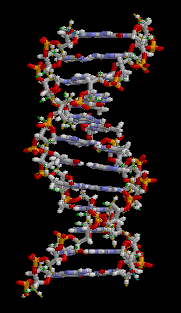 By now we all know that DNA is an informational molecule encoding the genetic instructions used in the development and functioning of all known living organisms and many viruses (Wikipedia). But very recently, Harvard University bio engineers at the Wyss Institute have shown that deoxyribonucleic acid can also be used as a tool. Specifically, two teams have published eye-opening studies on using DNA creatively to:
By now we all know that DNA is an informational molecule encoding the genetic instructions used in the development and functioning of all known living organisms and many viruses (Wikipedia). But very recently, Harvard University bio engineers at the Wyss Institute have shown that deoxyribonucleic acid can also be used as a tool. Specifically, two teams have published eye-opening studies on using DNA creatively to:
- Encode other information, including the text of a book
- Function as a building block, much like the ubiquitous LEGO toy
At first there seems to be something almost sacriligeous about treating DNA --which makes up who we are, after all-- as a mere alphabet or structural component. Fortunately this is science, and getting past a certain squeemishness with the fact that we are biophysical machines is when things get interesting.
[Animation of a rotating DNA structure, courtesy of Wikipedia]
Dr. George M. Church is a genetics professor at Harvard Medical School, one of the founders of Harvard's Wyss Institute for Biologically Inspired Engineering, and director of the NIH Center for Excellence in Genomic Science. It was his team that recently translated an entire book (his book, in fact, “Regenesis: How Synthetic Biology Will Reinvent Nature and Ourselves”) into DNA. Why? To show that DNA can be successfully used as an information storage material. Don't we already have a lot of those? Not with the heartiness, longevity, and capacity of DNA. According to Church, in a Science Recorder article:
“You can drop it wherever you want, in the desert or your backyard, and it will be there 400,000 years later.”
The first thing the Church team did was to translate the text and images from the book into binary code. Then they took those 1s and 0s and translated them into the four amino acids (ACTG) that make up DNA. They used a DNA chip rather than a living organism so that the information wouldn't be deleted when the organism realized it wasn't useful information for its own survival. In addition to the text and images, the code included instructions for reassembly. Church demonstrated this retrieval as well, and went on to give a reading of his book.
This experiment was part of a larger study funded by the Navy, so we can imagine there are potential military applications for such a coding technology.
The second recent DNA manipulation project was carried out by Wyss Institute researchers led by faculty member Peng Yin. Their goal is to create a flexible nanofabrication material, and they've done that by getting strands of synthetic DNA to self-assemble into little bricks of varying shapes. The LEGO-like bricks can then be used to build more intricately shaped objects. Applications for this nanotechnology include biological uses such as precise drug delivery, or even ever-smaller and more compact computer circuitboards. The research was published in the November 30 issue of Science.
Yin and Church work together as well, as both studies are part of the larger project of seeing just what we can do with this essential material. The answer, it seems, is pretty much anything.
George Church is also the director of PersonalGenomes.org, providing the world's only open-access information on human Genomic, Environmental & Trait data (GET). His innovations in next generation genome sequencing and synthesis and cell/tissue engineering have resulted in 12 companies.
Peng Yin is the recipient of the DARPA Young Faculty Award, the NSF Career Award, and the NIH Director's New Innovator Award. In addition to being a member of the core faculty at Wyss, he is a professor in the Department of Systems Biology at Harvard Medical.
For another recent blog of ours highlighting research at the Wyss Institute, read: Harvard Lung-on-a-Chip Biotechnology Breathes Life into Drug Research.
Biotechnology Calendar, Inc. will be on the Longwood Medical Campus next on February 21, 2013 for our 7th Annual Boston BioResearch Product Faire event. With life sciences researchers from Harvard Medical, Dana-Farber, Joslin Diabetes, Children's Hospital, MGH and the Wyss Institute attending, this is an excellent opportunity for scientists and laboratory equipment suppliers to network and discuss their research needs and solutions.
To see our 2013 show schedule, click here. For a funding report and info on the Boston show specifically, click the button:


